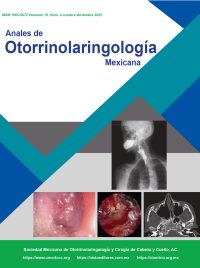
Prevalence of presbyphony in patients older that 65 years.
An Orl Mex. 2020 enero-marzo;65(1):9-13.
Gabriel Mauricio Morales-Cadena,1 Nydia Dessirée Jaurrieta-Hinojos,2 Mariana Gabriela Fonseca-Chávez3
1 Profesor titular del curso de posgrado de Otorrinolaringología y Cirugía de Cabeza y Cuello.
2 Alumno del curso de posgrado de Otorrinolaringología y Cirugía de Cabeza y Cuello.
3 Profesor invitado del curso de posgrado de Otorrinolaringología y Cirugía de Cabeza y Cuello.
Facultad Mexicana de Medicina, Universidad La Salle. Hospital Español de México, Ciudad de México.
Resumen
ANTECEDENTES: La presbifonía se define como los cambios en la voz relacionados con el envejecimiento. Se asocia con aislamiento social, síntomas de depresión y tendencia a que los pacientes justifiquen que la edad es la causa de sus problemas.
OBJETIVO: Determinar la prevalencia de presbifonía en pacientes mayores de 65 años que asisten al Servicio de Otorrinolaringología y Cirugía y Cuello del Hospital Español de México.
MATERIAL Y MÉTODO: Estudio descriptivo y transversal, en el que se incluyeron todos los pacientes que acudieron a la consulta del Servicio de Otorrinolaringología y Cirugía de Cabeza y Cuello del Hospital Español de México de noviembre de 2018 a febrero de 2019. Se incluyeron los pacientes mayores de 65 años que aceptaron contestar el cuestionario del índice de incapacidad vocal de 10 ítems (VHI-10).
RESULTADOS: Se incluyeron 64 pacientes. El 15.6% tuvo un VHI-10 anormal y en 84.4% fue normal.
CONCLUSIONES: La prevalencia obtenida (15.6%) están en los rangos reportados en las diferentes series de la bibliografía (5 a 47%). Es imperativo reconocer y tratar esta afección clínica en nuestra población, porque es un factor que puede determinar las funciones cognitivas y emocionales de los pacientes, así como su estado de salud.
PALABRAS CLAVE: Voz; adulto mayor.
Abstract
BACKGROUND: Presbyphony is defined as those changes related to voice aging. It is associated with social isolation, symptoms of depression and a tendency to justify that age is the cause of their problems.
OBJECTIVE: To determine the prevalence of presbyphony in patients over 65 years attending the Otolaryngology and Neck Surgery Service of the Hospital Español de Mexico.
MATERIAL AND METHOD: A descriptive and transversal study including all patients over 65 years, who attended the Otolaryngology and Head and Neck Surgery Service of the Hospital Español de Mexico from November 2018 to February 2019, and agreed to carry out the voice handicap index-10 (VHI-10).
RESULTS: A total of 64 patients were included. The VHI-10 was abnormal in 15.6% and normal in 84.4%.
CONCLUSIONS: The prevalence obtained (15.6%) is within the reported in the different series of the literature (5 to 47%). It is imperative to recognize and treat this clinical entity in our population, because it can determine the cognitive and emotional functions of patients; as well as their health condition.
KEYWORDS: Voice; Elderly.

